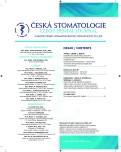Occlusal Interference – Part One
Authors:
K. Francová; M. Eber
Authors‘ workplace:
Klinika zubního lékařství LF UP a FN, Olomouc
Published in:
Česká stomatologie / Praktické zubní lékařství, ročník 114, 2014, 1, s. 7-14
Category:
Review Article
Overview
Introduction:
Review summarizes current knowledge concerning occlusal interferences. Occlusal interference is defined as any tooth contact that inhibits the remaining occluding surfaces from achieving stable and harmonious contacts. Similar meaning have terms deflective occlusal contact and occlusal disturbance. In this review, a current theoretical concept about stable and harmonious contacts in natural dentition is presented. In this concept, occlusal contacts are judged by their relationship to temporomandibular joints, and in static and dynamic occlusion.
Objectives:
Occlusal interferences can be divided into interferences in static and interferences in dynamic occlusion. Interferences in static occlusion comprise interferences to centric relation (centric interferences), interferences against even distribution of occlusal forces in maximal intercuspation and interferences against long centric. Interferences in dynamic occlusion comprise protrusive interferences, working-side interferences and non-working side interferences. The prevalence of occlusal interferences in population is high, an ideal occlusion is present rarely.
Occlusal interferences arise on the basis of genetic information or during the development of an individual due to diverse factors. They may be iatrogenic as well. Occlusal interferences work as microtrauma. Their pathologic effect is dependent on the type and intensity of the interference, the intensity of function (occlusal forces and their duration), the extent of functional and parafunctional movements and adaptive capacities of the organism. Typical clinical signs caused by occlusal interferences are signs of periodontal destruction (mobility and migration of tooth), atypical occlusal wear, tooth hypersensitivity, infractions and fractures of teeth, destruction of dental restorations (eg. chopping of dental ceramics of esthetic veneers), instability of complete dentures. Occlusal interferences may contribute to the development of temporomandibular disorders, bruxism, headaches, psychical tension and other problems.
Diagnostics of occlusal interferences is based on anamnesis, clinical examination, and instrumental examination when needed. Therapy of occlusal interferences is indicated strictly on the individual basis, as the situation of the concrete patient requires. In therapy, occlusal splints, occlusal equilibration, orthodontic therapy, restorative and prosthetic therapy, surgery may be required.
In prevention, the focus should be on the prevention of iatrogenic occlusal interferences. Before any dental treatment with the potential of changing the occlusion, an examination of occlusion and the decision whether to change it or not should be made. The dental treatment should adhere to the plan and after the dental treatment, the control examination should be made.
Key words:
occlusal interferences – occlusal disturbances – deflective occlusal contact – traumatogenic occlusion – functional occlusion – occlusal concepts – occlusal contacts – occlusion
Sources
1. Becker, I. M.: Comprehensive occlusal concepts in clinical practice. Wiley-Blackwell 2011. ISBN: 978-0-470-95865-0.
2. Clark, G. T., Tsukiyama, Y., Baba, K., Watanabe, T.: Sixty-eight years of experimental occlusal interferences: What have we learned? J. Prosthet. Dent., roč. 82, 1999, s. 704–713.
3. Clark, J. R., Evans, R. D.: Functional occlusion: I. A review. J. Orthod., roč. 28, 2001, č. 1, s. 76–81.
4. Davies, S. J., Gray, R. J. M.: A clinical guide to occlusion. London, British Dental Association, 2002. ISBN: 0-904588-68-8.
5. Diedrich, P., Mutschelknauss, R. E.: Funkční poruchy – diagnostika, Funkční terapie – zábrusy. In Mutschelknauss, R. E.: Praktická parodontologie klinické postupy. Praha, Quintessenz, 2002. ISBN 80-902118-8-7.
6. Dawson, P. E.: Functional occlusion: From TMJ to Smile Design. Mosby, 2007. ISBN 978-0-323-03371-8.
7. Glossary of Occlusal Terms Formulated by the Glossary Committee of the International Academy of Gnathology, September 1985 [on line, cit. 2012-20-11] Dostupný z: http://www.gnathologyusa.org/got_a-q.html.
8. Mohl, N. D., Zarb, G. A., Carlsson, G. E., Rugh, J. D.: A textbook of occlusion. Quintessence Publishing, 1988. ISBN 0-86715-167-6
9. Okeson, J. P.: Management of temporomandibular disorders and occlusion. 6. vyd. St. Louis, Elsevier Mosby, 2008. ISBN 978-0-323-04614-5.
10. Parsche, E.: Funktionslehre [on line, cit. 2012-30-09] Dostupný z http://www.medunigraz.at/zahnklinik/Download/FunktionslehreBiomechanik.pdf.
11. Rinchuse, D. J., Kandasamy, S., Sciote, J.: A contemporary and evidence-based view of canine protected occlusion. Amer. J. Orthodont. Dentofacial Orthoped., roč. 132, 2007, č. 1, s. 90–98.
12. Shillingburg, H.: Fundamentals of fixed prosthodontics. 3. vyd. Quintessence Publishing, 1997.
13. Spear, F. M.: Occlusal considerations for complex restorative therapy. In McNeill, C.: Science and practice of occlusion. Chicago, Quintessence, 1997, s. 437–456.
14. Strub, J. R., Türp, J. C., Witkowski, S., Hürzeler, M. B., Kern, M.: Curriculum Prothetik Band I, 3. vyd. Berlin, Quintessenz Verlags-GmbH, 2005. ISBN: 3-87652-434-2.
15. Terminologieliste der Deutschen Gesellschaft für Funktionsdiagnostik und Therapie (DGFDT) und der Deutschen Gesellschaft für zahnärztliche Prothetik und Werkstoffkunde (DGzPW) (verabschiedet 01.09.2005) [on line, cit. 2012-30-11].
16. The Academy of Prosthodontics. The glossary of prosthodontic terms, 8. vyd. (GPT-8). J. Prosthet. Dent., roč. 94, 2005, č. 1, s. 10–92. Dostupný z http://www.dgfdt.de/fileadmin/docs/06_Stellungnahme_Terminologie.pdf
17. Türp, J. C., Greene, C. S., Strub, J. R.: Dental occlusion: a critical reflection on past, present and future concepts. J. Oral Rehab. roč. 35, 2008, č. 6, s. 446–453.
18. Vence, B. S.: Predictable esthetics through functional design: the role of harmonious disclusion. J. Esthet. Restor. Dent., roč. 19, 2007, č. 4, s. 185–191.
19. Williamson, E. H., Lundquist, D. O.: Anterior guidance: its effect on electromyographic activity of the temporal and masseter muscle. J. Prosthet. Dent., roč. 49, 1983, č. 6, s. 816–823.
20. Zemen, J.: Rukověť zubního lékaře temporomandibulární poruchy v praxi. Praha, Česká stomatologická komora, 2008. ISBN:978-80-87109-10-6.
Labels
Maxillofacial surgery Orthodontics Dental medicineArticle was published in
Czech Dental Journal

2014 Issue 1
- What Effect Can Be Expected from Limosilactobacillus reuteri in Mucositis and Peri-Implantitis?
- The Importance of Limosilactobacillus reuteri in Administration to Diabetics with Gingivitis
Most read in this issue
- Occlusal Interference – Part One
- Tooth Agenesis and Associated Tooth Developmental Anomalies
- Early Childhood Caries and its Consequences
- Central Giant Cell Granuloma – Conservative Treatment with Intralesional Application of Corticosteroids
